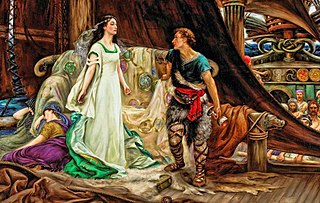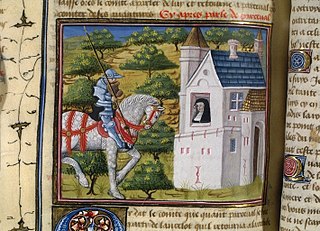Related Research Articles

The Round Table is King Arthur's famed table in the Arthurian legend, around which he and his knights congregate. As its name suggests, it has no head, implying that everyone who sits there has equal status, unlike conventional rectangular tables where participants order themselves according to rank. The table was first described in 1155 by Wace, who relied on previous depictions of Arthur's fabulous retinue. The symbolism of the Round Table developed over time; by the close of the 12th century, it had come to represent the chivalric order associated with Arthur's court, the Knights of the Round Table.
Rustichello da Pisa, also known as Rusticiano, was an Italian romance writer in Franco-Italian language. He is best known for co-writing Marco Polo's autobiography, The Travels of Marco Polo, while they were in prison together in Genoa. Earlier, he wrote the Roman de Roi Artus, also known as the Compilation, the earliest known Arthurian romance by an Italian author.

Lohengrin is a character in German Arthurian literature. The son of Parzival (Percival), he is a knight of the Holy Grail sent in a boat pulled by swans to rescue a maiden who can never ask his identity. His story, which first appears in Wolfram von Eschenbach's Parzival, is a version of the Knight of the Swan legend known from a variety of medieval sources. Wolfram's story was expanded in two later romances. Richard Wagner's opera Lohengrin of 1848 is based upon the legend.

Tristan and Iseult, also known as Tristan and Isolde and other names, is a medieval chivalric romance told in numerous variations since the 12th century. Of disputed source, usually assumed to be primarily Celtic, the tale is a tragedy about the illicit love between the Cornish knight Tristan and the Irish princess Iseult in the days of King Arthur. It depicts Tristan's mission to escort Iseult from Ireland to marry his uncle, King Mark of Cornwall. On the journey, Tristan and Iseult ingest a love potion, instigating a forbidden love affair between them.

Perceval, the Story of the Grail is the unfinished fifth verse romance by Chrétien de Troyes, written by him in Old French in the late 12th century. Later authors added 54,000 more lines to the original 9,000 in what are known collectively as the Four Continuations, as well as other related texts. Perceval is the earliest recorded account of what was to become the Quest for the Holy Grail but describes only a golden grail in the central scene, does not call it "holy" and treats a lance, appearing at the same time, as equally significant. Besides the eponymous tale of the grail and the young knight Perceval, the poem and its continuations also tell of the adventures of Gawain and some other knights of King Arthur.

Erec and Enide is the first of Chrétien de Troyes' five romance poems, completed around 1170. It is one of three completed works by the author. Erec and Enide tells the story of the marriage of the titular characters, as well as the journey they go on to restore Erec's reputation as a knight after he remains inactive for too long. Consisting of about 7000 lines of Old French, the poem is one of the earliest known Arthurian romances in any language, predated only by the Welsh prose narrative Culhwch and Olwen.
Cligès is a poem by the medieval French poet Chrétien de Troyes, dating from around 1176. It is the second of his five Arthurian romances; Erec and Enide, Cligès, Yvain, Lancelot and Perceval. The poem tells the story of the knight Cligès and his love for his uncle's wife, Fenice.
Daniel von dem blühenden Tal is an Arthurian romance composed around 1220 by the Middle High German poet Der Stricker, who claimed he had received the story from a French troubadour. It tells how Sir Daniel, heir to the kingdom of Blumenthal, becomes a Knight of the Round Table and engages in fantastic adventures to defend King Arthur's land from an enemy ruler.

Ulrich von Zatzikhoven was the author of the Middle High German Arthurian romance Lanzelet. Ulrich's name and his place of origin are only known definitively from the work itself. However, it is generally accepted that Ulrich is the same person as a lay priest ("Leutpriester") from Lommis in the canton of Thurgau by the name of Uolricus de Cecinchoven, who occurs as a witness to a deed of gift dated 29 March 1214, executed by the family of the Counts of Toggenburg in favor of the monastery of St. Peterzell.
Perlesvaus, also called Li Hauz Livres du Graal, is an Old French Arthurian romance dating to the first decade of the 13th century. It purports to be a continuation of Chrétien de Troyes' unfinished Perceval, the Story of the Grail, but it has been called the least canonical Arthurian tale because of its striking differences from other versions.
Eilhart von Oberge was a German poet of the late 12th century. He is known exclusively through his Middle High German romance Tristrant, the oldest surviving complete version of the Tristan and Iseult story in any language. Tristrant is part of the "common" or "primitive" branch of the legend, best known through Béroul's fragmentary Norman language Tristan. It is German literature's first rendition of the story, though Gottfried von Strassburg's Tristan, part of the "courtly" branch, is more famous and respected.
Brangaine is the handmaid and confidante of Iseult of Ireland in the Arthurian legend of Tristan and Iseult. She appears in most versions of the story.
Garel von dem blühenden Tal is a Middle High German Arthurian romance composed by Der Pleier around 1230-40. It appears to have been written in contradiction to Der Stricker's Daniel von Blumenthal. It consists of 21,310 lines in rhyming couplets; the beginning is missing. The story is illustrated in frescoes to be found at Runkelstein Castle in South Tyrol.

Runkelstein Castle is a medieval fortification on a rocky spur in the territory of Ritten, near the city of Bolzano in South Tyrol, Italy. In 1237 Alderich Prince-Bishop of Trent gave the brothers Friedrich and Beral Lords of Wangen permission to construct a castle on the rock then called Runchenstayn.
Der Pleier is the pen name of a 13th-century German poet whose real name is unknown. Three of his works survive, all Middle High German romances on Arthurian subjects: Garel, Tandareis und Flordibel, and Meleranz. Little else is known of him, but he was an important figure in the revival of Arthurian literature in Germany in the mid-13th century, after decades of declining interest in the subject.
Brother Robert was a cleric working in Norway who adapted several French literary works into Old Norse during the reign of King Haakon IV of Norway (1217–1263). The most important of these, Tristrams saga ok Ísöndar, based on Thomas of Britain's Tristan, is notable as the only example of Thomas' "courtly branch" of the Tristan and Iseult legend that has survived in its entirety. It was the earliest Scandinavian version of the story, and is thought to be the first Norwegian adaptation of an Old French work. Its success may have inspired the spate of translations during King Haakon's reign.
Kairo-kō: A Dirge is a 1905 novel by the Japanese author Natsume Sōseki. The earliest, and only major, prose treatment of the Arthurian legend in Japanese, it chronicles the adulterous love triangle between Lancelot, Guinevere, and Elaine of Astolat.
Palamedes is a 13th-century Old French Arthurian prose chivalric romance. Named for King Arthur's knight Palamedes, it is set in the time before the rise of Arthur, and relates the exploits of the parents of various Arthurian heroes. The work was very popular, but now exists largely in fragmentary form.
Béroul was a Norman or Breton poet of the mid-to-late 12th century. He is usually credited with the authorship of Tristran, a Norman language version of the legend of Tristan and Iseult, of which just under 4500 verses survive in a manuscript of the 13th century. His name is known only from two references in the text of the poem.
Moriaen is a 13th-century Arthurian romance in Middle Dutch. A 4,720-line version is preserved in the vast Lancelot Compilation, and a short fragment exists at the Royal Library at Brussels. The work tells the story of Morien, the Moorish son of Aglovale, one of King Arthur's Knights of the Round Table.
References
- 1 2 3 Gürttler, Karin R. (1991). "Der Stricker". In Lacy, Norris J., The New Arthurian Encyclopedia, p. 434. New York: Garland. ISBN 0-8240-4377-4.
- 1 2 Tax, Petrus W. (1991). "Der Pleier". In Lacy, Norris J., The New Arthurian Encyclopedia, pp. 362–363. New York: Garland. ISBN 0-8240-4377-4.
- Lacy, Norris J. (Ed.) (1991). The New Arthurian Encyclopedia. New York: Garland. ISBN 0-8240-4377-4.